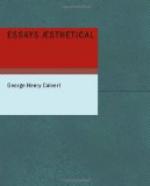Above the pungent secularities, the nimble intellectualities, the specious animalism, the derisive skepticism, the snapping personalities, the witty worldliness, that interlace and constitute the successive cantos of “Don Juan,” the passages just quoted and similar ones (they are not many) rise, as above the desires and the discontents, the plots and contentions, the shrewd self-seekings of a heated, noisy city rises a Gothic spire, aspiring, beautiful, drawing most of its beauty from its aspiration, on whose pinnacle, calmly glistening in the upper air, plays the coming and the parting day, while shadows fill the streets below, and whose beauty throws over the town a halo that beckons men from afar. The spire, in its steadfast tranquillity and its beauty, so unlike the restless wrangling dissonance below it, grew nevertheless out of the same hearts that make the dissonance, and, typifying what is spiritual and eternal in them, tends by its ideal presence to enlarge and uplift those by whose eyes it is sought. These upshootings in “Don Juan” irradiate the cantos, giving an attractiveness which draws to them eyes that otherwise would not have known them; and if too pure in their light and too remote to mingle directly with the flare and flash that dazzle without illuminating, silently they shine and steadily, an unconscious heavenly influence, above these coruscations of earthly thoughts,—thoughts telling from their lively numerousness, but neither grand nor deep.
From the same solar center fall frequently single rays that make lines and stanzas glisten, and but for which this poem, lacking their perfusive light, would soon pass into oblivion; for from the beautiful it is that the satire, the wit, the voluptuousness get their sparkle and their sheen. If passages morally censurable are hereby made more captivating, we are not content with saying that God’s sun fructifies and beautifies poison-oak and hemlock; but we affirm that the beautiful, being by its nature necessarily pure, communicates of its quality to whoever becomes aware of it, and thus in some measure counterweighs the lowering tendency. Moreover, the morally bad, deriving its character of evil from incompleteness, from the arresting or the perversion of good, like fruit plucked unripe, and being therefore outside the pale of the beautiful (the nature of which is completeness, fullness, perfection of life) cannot by itself be made captivating through the beautiful. Iago and Edmund are poetical as parts of a whole; and when in speech they approach the upper region of thought, it is because the details allotted to them have to be highly wrought for the sake of the general plot and effect, and further, because humanity and truth speak at times through strange organs. Besides, the ideal may be used to show more glaringly the hideousness of evil, and thence Iago and Edmund, as ideal villains, through the very darkness in which only poetic art could have enveloped them, help us by indirection to see and value the lights that surround the noble and the good.




